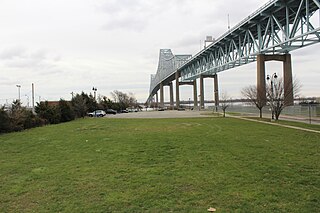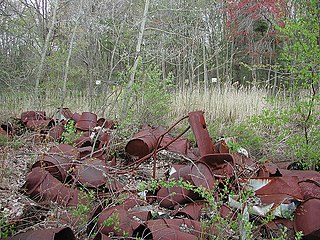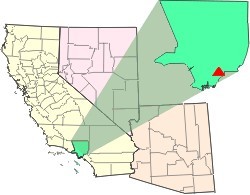
Asarco LLC is a mining, smelting, and refining company based in Tucson, Arizona, which mines and processes primarily copper. The company has been a subsidiary of Grupo México since 1999.
Vapor intrusion (VI) is a process by which chemicals in soil or groundwater - especially Volatile Organic Compounds (VOCs) - migrate to indoor air above a contaminated site.
Havertown Superfund is a 13-acre polluted groundwater site in Havertown, Pennsylvania contaminated by the dumping of industrial waste by National Wood Preservers from 1947 to 1991. The state first became aware of the pollution in 1962 and initiated legal action against the owners in 1973 to force them to cleanup the site. The Environmental Protection Agency (EPA) ranked the site the eighth worst cleanup project in the United States. The site was added to the National Priorities List in 1983 and designated as a Superfund cleanup site in the early 1990s. Remediation and monitoring efforts are ongoing and the EPA transferred control of the site to the Pennsylvania Department of Environmental Protection in 2013.

Dorney Road Landfill is a 27-acre municipal and industrial landfill in Upper Macungie Township and Longswamp Township, Pennsylvania that was polluted with toxic waste from 1952 to 1978. The site is surrounded by rural residences and farmland. The U.S. Environmental Protection Agency (EPA) added the site to the Superfund National Priorities List in 1984. The site was remediated and removed from the National Priorities List in 2018.

In 1990, the Allied Paper, Inc./Portage Creek/Kalamazoo River in southwestern Michigan was declared by the Environmental Protection Agency (EPA) to be a Superfund site – in other words, an abandoned industrial site containing significant amounts of toxic waste. The EPA and companies responsible for the waste in this area, which includes a three-mile section of Portage Creek as well as part of the Kalamazoo River, into which it flows, are currently involved in an effort to reduce the amount of toxic waste at the site, which is contaminated by PCBs from paper mills and other factories.

Wade Dump was a rubber recycling facility and illegal industrial waste storage and disposal facility in Chester, Pennsylvania. It was located at 1 Flower Street on the western bank of the Delaware River just north of the Commodore Barry Bridge.
The Del Amo Superfund Site is located in southern Los Angeles County between the cities of Torrance and Carson. It is a U.S. EPA Region 9 Superfund Site. The waste-disposal site of a rubber manufacturer is one of 94 Superfund Sites in California as of November 29, 2010.

Shpack Landfill is a hazardous waste site in Norton, Massachusetts. After assessment by the United States Environmental Protection Agency (EPA) it was added to the National Priorities List in October 1986 for long-term remedial action. The site cleanup is directed by the federal Superfund program. The Superfund site covers 9.4 acres, mostly within Norton, with 3.4 acres in the adjoining city of Attleboro. The Norton site was operated as a landfill dump accepting domestic and industrial wastes, including low-level radioactive waste, between 1946 and 1965. The source of most of the radioactive waste, consisting of uranium and radium, was Metals and Controls Inc. which made enriched uranium fuel elements for the U.S. Navy under contract with the U.S. Atomic Energy Commission. Metals and Controls merged with Texas Instruments in 1959. The Shpack landfill operation was shut down by a court order in 1965.
The Alabama Plating Company Superfund site is a former industrial site in Vincent, Alabama. The site covers 6 acres and was used by the Alabama Plating Company as an electroplating facility between 1956-1986. The facility caused contamination of the ground water with hazardous waste containing heavy metals. After assessment by the United States Environmental Protection Agency (EPA) it was added to the National Priorities List in September 2012 for remedial action. The site cleanup is directed by the federal Superfund program.
The Capitol City Plume, which also is referred to as the Capital City Plume, is an area of contaminated groundwater located beneath the western downtown area of Montgomery, Alabama. The contamination was discovered in 1993 by the Alabama Department of Environmental Management (ADEM) which was investigating soil contamination at the Retirement Systems of Alabama Energy Plant in the city. After assessment by the United States Environmental Protection Agency (EPA) it was proposed for inclusion in the National Priorities List (NPL) in May 2000.

The Koppers Co., Inc. (KCI) Superfund Site is one of three Superfund sites in Oroville, California, along with Louisiana Pacific Sawmill and Western Pacific Railyard. The KCI Superfund Site is a 200-acre site which served as a wood treatment plant for 50 years. Wood was treated with many chemicals to prevent wood deterioration. The accumulation of these chemicals from spills, fires, and uses has caused this site to be contaminated with the hazardous waste material. Due to soil and groundwater contamination, the site was placed on the National Priorities List in 1984 for remedial action plans to clean up the site to protect surrounding residential areas concerning environmental and human health risks.

The Waste Disposal Inc. Superfund site is an oil-related contaminated site in the highly industrialized city of Santa Fe Springs in Los Angeles County, California. It is approximately 38 acres (15 ha), with St Paul's high school immediately adjacent to the northeast corner of the site. Approximately 15,000 residents of Santa Fe Springs obtain drinking water from wells within three miles (4.8 km) of the site.
Kauffman & Minteer Inc. (K&M) was an industrial transportation company that operated from 1960 to 1981 in Burlington County, New Jersey. After cleaning their trucks, they dumped the waste water into a nearby lagoon that was not properly lined. The lagoon flooded and the waste water containing chemicals, migrated over to wetlands, causing damage to vegetation and seeping into underground drinking water. The Environmental Protection Agency (EPA) got involved in 1989 and conducted a few remediation attempts but the extent of the damage is hard to determine as the different underground pathways of water are unpredictable. The site is currently an active superfund site that is closely monitored by the EPA.
Emmell's Septic Landfill (ESL) is located at 128 Zurich Ave, Galloway Township, New Jersey and takes up about 38 acres of space. The landfill was in operation from 1967 until 1979. ESL disposed of liquid and solid waste including many chemicals such as volatile organic compounds (VOCs), Polychlorinated Biphenyls (PCBs), Trichloroethene and Vinyl chloride which all had their own effect on the environment and community. These chemicals affected the groundwater required millions of dollars to reconstruct the groundwater pathways and provide clean water to residents. The landfill holds a Hazardous Ranking Score of a 50/100, qualifying for the Superfund National Priority List. In August 1999, the state acknowledged the site's contamination and held town meetings and provided research upon the site such as groundwater samples. In July 1997, a sitewide investigation was called upon by the United States Environmental Protection Agency. In total the clean up was estimated to cost $5 million to fund this superfund site, and a grant of $3.9 million was given by the Federal Government under the Recovery Act Funding (Previti). Today, the project is still ongoing however, greatly improved since the landfill was discovered.
Brook Industrial Park (BIP) is an industrial area occupying 4.5 acres of the Borough of Bound Brook, New Jersey, in the United States of America. It is located on the northern bank of the Raritan River. Industrial, chemical and pesticide operations began in 1971 and eventually lead to the contamination of groundwater and exposure of workers to harmful dioxins. Throughout 1980 to 1988 the United States Environmental Protection Agency (EPA) and the New Jersey Department of Environmental Protection (NJDEP) conducted studies to determine if there were any threats being posed on the workers, community or environment by the BIP companies in their disposal of processed and stored chemicals.
The Zschiegner Refining Company (ZRC) was located in Howell, New Jersey, and operated as a metal refining facility. Some of their operations included stripping the chemicals off of precious metals from watch bands, photographic film, and electrical components. In 1992, the United States Environmental Protection Agency (EPA) discovered that 3,000 chemicals had contaminated the soil, surface water, and groundwater. These areas were contaminated due to discharge of waste to the ground surface, the movement of waste and contamination downhill from the site building, along with surface water runoff. When the EPA investigated the site and found the chemicals in the groundwater and soil, they shut down the company that same year in 1992. In that area, the environment and people were affected, especially the workers in the facility. After a Hazard Ranking System report was conducted by the EPA, the site was placed on the National Priorities List in March 1998. In 2008, the cleanup was completed, but groundwater and wetland is still being monitored.

Ohio River Park is a Superfund Site located in Neville Island, Pennsylvania. Between the 1920s-1970s, the Site was used for municipal waste, pesticide manufacturing, coke sludge disposal, cement manufacturing disposal, and pesticide waste. In 1977, Neville Land Company donated the Site to Allegheny County who started developing the Site as a community park. In 1979, Allegheny County found various hazardous contaminants on the Site. On August 30, 1990, the Site was determined to be a Superfund Site due to VOCs, SVOCs, inorganics, and pesticides being present in the surface soil, subsurface soil, surface water, river sediment, and groundwater. Soil remediation began in February 1998 and ended in September 1999. Today, Ohio River Park has the Robert Morris University Island Sports Center and Coraopolis Bridge on top of it. Additionally, benzene continues to be monitored because it is still present in the Site's groundwater.









